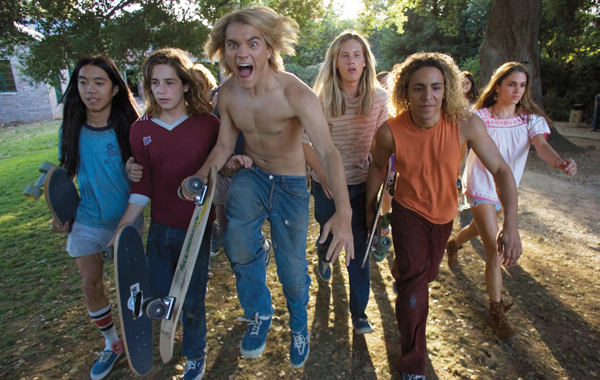Movie review by Greg Carlson
Director Catherine Hardwicke’s follow-up to her edgy “Thirteen,” “Lords of Dogtown” covers similar territory in its depiction of angst-ridden young people struggling with issues large and small. A fictionalized re-imagining of the rise and fall of Venice Beach’s legendary Zephyr skateboard team, “Lords” already enjoyed big screen success in Stacy Peralta’s 2001 documentary “Dogtown and Z-Boys” – not incidentally a much stronger film. While Peralta’s movie did a better job of profiling the personalities of the skaters, Hardwicke (working from a script by Peralta) settles in on the key trio: chronicler Peralta, flashy Tony Alva, and troubled Jay Adams. Ultimately too conventional to accurately account for the seismic pop-culture shock spawned by the Z-Boys, “Lords of Dogtown” is just intriguing enough to merit a look.
Like Peralta’s original, “Lords of Dogtown” traces the birth of skateboard culture to the Pacific Ocean Park pier, where hardcore surfers formed a tightly-knit group of friends committed to the “locals only” philosophy. Led by Zephyr surf shop owner Skip Engblom (colorfully portrayed by Heath Ledger in a performance that immediately calls to mind Val Kilmer as Jim Morrison in “The Doors”), a gang of younger wannabes latches on to the dubious role model in what proves to be an interestingly symbiotic relationship. With the introduction of urethane wheels, which enable the skaters to emulate surfer moves on asphalt, Engblom launches a competitive team – along with a plan to sell skateboards with the Zephyr logo to kids who want to imitate the radical youngsters in Engblom’s somewhat elite company.
What follows is a fairly standard series of scenes that recounts the history of street skating at ground zero. Southern California’s mid-70s water shortage opened up a concrete ocean of drained swimming pools, and the Z-Boys were quick to invent and perfect the jaw-dropping moves that are now familiar to millions of kids. Hardwicke manages to recreate much of the electrifying awe that accompanied the very first sightings of Tony Alva (Victor Rasuk) going vertical over the lip of the bowl, and many other well-known photographs by Craig Stecyk and Glen E. Friedman are also lovingly, faithfully reproduced.
The skating is much better than the melodramatic renderings of the central characters’ personal lives, which all end up reduced to recognizable screen tropes. As Jay Adams, Emile Hirsch leaves the strongest impression. Adams was never able to ride his board to commercial success (both Peralta and Alva quickly capitalized on their skills, despite the fact that Adams was every bit their equal on a deck), and his story arc hints at the frustration and pain he experienced, even as it mostly sidesteps his substance abuse problems. Perhaps erring on the side of modesty, screenwriter Peralta has himself portrayed by beautiful, golden-haired John Robinson as a pretty square, straight shooter. Despite Robinson’s pleasantness, Peralta fails to give himself anything approaching complexity.
Alva’s role is just as underdeveloped, despite Rasuk’s best efforts to mimic the famous pro’s penchant for fast cars and attractive young women. Nikki Reed teams again with Hardwicke, playing Alva’s sexy sister, who ends up as one of the points in a love triangle with Peralta and Adams. Compared to the version of history presented in “Dogtown and Z-Boys,” “Lords of Dogtown” applies a nostalgic gloss, concocting composite characters and ignoring several influential figures. As a summer diversion and with the help of a great soundtrack, however, the movie often capitalizes on its youthful energy. That said, it would be criminal to see “Lords” without taking in “Dogtown and Z-Boys” as a companion piece.
